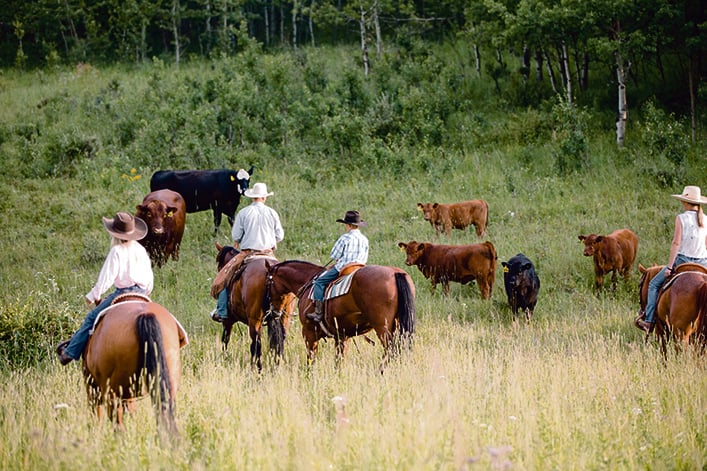National Film Board takes producers down memory lane after posting a 1971 documentary that features family members
The re-emergence online of a documentary film first released more than a half century ago has an Alberta ranching family looking back on its past as it faces the future.
How Things Have Changed was released by the National Film Board of Canada in 1971. Although it was partly meant to be a tribute to the cowboy days of the open range of the early 1900s, it has come to mean something else to Rachel Herbert of Trail’s End Beef.
It includes shots of her uncle, Lance Loree, riding a horse as a young teenager in 1969 as he helped his late parents, Bill and Con, and sister, Mavis, drive their cattle from the Midway Ranch to the summer range of the Trail’s End Ranch in the Porcupine Hills near Nanton, Alta.
“It was really special, especially now that my aunt Mavis has passed away in just the last few years,” said Herbert. “And Bill and Con are kind of icons of our family, so it was really neat to see them all together, see the family resemblances, and especially to my kids who watched it with us, they could recognize the points on the road where we ride now.”
As someone who is now 68, Lance joked, “I don’t feel all that old until I look in the mirror … I have a 28-year-old daughter and she was really happy to see her grandparents and her aunt on there, you know.”
The NFB recently posted the nine-minute film on its website for free streaming as part of an ongoing initiative to digitize its holdings, said collection curator Camilo Martin-Florez. It has so far converted about 6,000 films out of a total collection of about 18,000, he said.
How Things Have Changed was shot between May 24 and June 3, 1969.
“From the ranchlands of Alberta, a picture of the cattle drive as it is today, when big cattle-liners truck the livestock to receiving stations on the summer range,” said a description by the NFB.
“But archival photographs tell how it was in the old days when the cowboy was king, driving his herd by easy stages to distant, greener pastures. Big sky, undulating hills and distant mountains still hold the spell and romance of the West that old-timers remember.”
Alberta Beef Producers general manager Brad Dubeau, 50, wasn’t even born when the film was released. Technological advances such as genetics in the last half century have transformed the beef industry, he said.
Most producers also use off-road vehicles such as quads rather than horses to manage their cattle. However, much like the Loree family in the film, Dubeau and his family still use horses to trail their cattle to their summer pasture near Medicine Hat, Alta.
“And sometimes, I think we forget — like, for me, personally, it’s a time to slow down and take a breath and just enjoy the environment around me with the cattle and riding your horse.”
Herbert said her part of the Eastern Slopes of the Rocky Mountains was her “true love,” describing it as some of the most beautiful cattle-raising country in Canada.
“And the open spaces and wildlife and the good grass and clean water, those are all of the things that my grandparents (Bill and Con) and my great-grandparents cherished, and that’s what we cherish, and when we’re making our stewardship and management decisions, they’re really based on trying to look after that land so it’s going to stay in good shape for the future generations.”
Herbert and her husband, Tyler, currently manage the Trail’s End Ranch. Along with the Midway Ranch, it was started by her late great-grandfather, Fred Ings, who also co-founded the historic OH Ranch near Longview, Alta., in 1883.
Ings is noted for writing a book of memoirs in 1936 called Before the Fences, which is about the open range days of early ranching in what is now Alberta. Herbert, who has a master’s degree in history, wrote a book entitlted Ranching Women in Southern Alberta.
She and her husband raise grass-fed beef using traditional methods involving low-stress handling, she said.
“We use horses and dogs, and have our cattle trained to really move quietly with horses and dogs, so yeah, those old traditions are really still the way of the future in terms of handling your cattle well.”
Although a ministerial order currently restricts coal development in the Eastern Slopes, she fears open-pit coal mining involving mountaintop removal could still occur in her area, contaminating the headwaters of the Saskatchewan River system.

“And we know where our wind comes from, so all of that coal dust would be blowing off of the mountains and onto Canada’s finest ranch lands and intact grasslands.”
She also fears the impact of climate change on the Eastern Slopes. “I mean, the weather patterns have always gone up and down … but we are definitely seeing a trend to warmer, drier summers and it’s impacted our springs, it’s impacted our wells, it’s impacted our streams,” she said.
“We’re almost running out of water along the Porcupine Hills in a lot of locations, and it’s real, so we’re going to have to start thinking about what we can do, and luckily, cows and grass are a perfect fit. So, if we can keep our grasslands healthy, that’s going to be one of the biggest things we can do to do our part to mitigate climate change.”
As part of the current generation of her extended family managing the Trail’s End and Midway ranches, she said they’ve “never felt a real ownership of the place. It’s more based on this is our turn to look after it, and we hope we can do a good job and leave it in better shape so it can carry on down the road.”


















